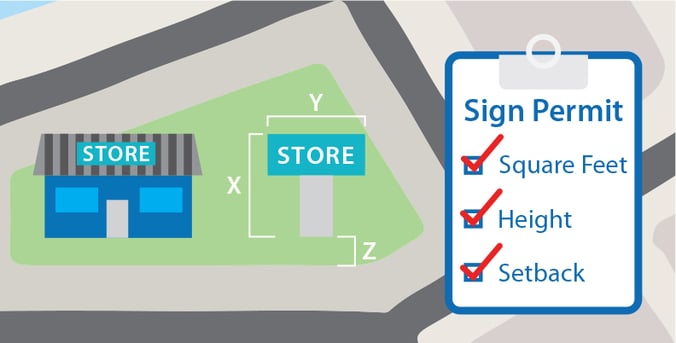City Permitting 101 - Why You Want to Leave the Permitting to Us
Topics: Education
When Do I Need a Sign Permit?
Whether you are installing a new sign or updating an existing sign, you will need a city permit. City codes, site surveys, engineering approval, variances can all be a part of the permitting process.
By issuing sign permits, cities ensure that you meet the standards of public safety, design aesthetics or heritage preservation requirements.
Why you don’t want to handle permitting yourself
Trying to figure out the various rules and regulations and the documents you need to submit for permitting can be an arduous, time consuming task. And these rules and regulations differ from city to city.
What works in one city may not work in another. Failing to follow the rules and regulations may result in fines, delays or denial. City codes cover things like:
-
Types of signs allowed
-
Sign placement
-
Set back requirements and property line information
-
Size allotments
-
Materials and construction requirements
-
Installation, anchoring and inground installation requirements
-
Lighting and digital display requirements
That's why our Spectrum Sign Systems team does all of the heavy lifting for you. Our team has 20 years of experience in permitting. We’ve built relationships with city planners and can pick up the phone and ask questions. We are up-to-date on rules and regulations and have staff dedicated to managing the permitting process and the intricacies of city processes.
You'll never have to worry about the permitting process or having to make costly changes after installation. From the sign permit application to the installation of your business signage, we are here to make the process as hassle-free as possible.
The Permitting Process
Goals
We start with a discussion of your goals for the project. Once we have a clear idea of your goals and what the sign package entails, the next step is a site survey.
Site Survey
A site survey helps us determine the best location for sign placement. We come to your location and look at traffic patterns, areas that provide the best visibility, utility placements, property lines, etc. We look at the existing landscaping and assess future growth that could impede the view of your sign.
City Permitting
Next, our dedicated permitting staff research the city rules and regulations. We start talking to the city planners on the front end of a project, before it is even designed, so we know what is allowed. We fill out the permitting form with all the owner information, property identification numbers, and legal description of the property.
Next, we create sign drawings that have all the dimensions, materials, and attachment information so the city can look at the drawings and clearly know what is being proposed. The more information we give them on the front end, the less they will have to come back to us with questions.
Types of documents that may be needed for submission
-
Sign drawings, site survey and site plan with property lines and markers
-
County maps
-
Google aerial photo and other photos of the property
-
Elevation and structural drawings
By the time that Spectrum Signs is submitting your sign package to the city, we’ve ensured that everything is within code and ready for approval.

Permitting requirements are getting tougher
Some cities are really cracking down on the installation of signs and want it to be a part of the construction process rather than an ancillary accessory. Cities are trying to protect themselves and want to make sure that the signs aren’t going to fall down and can withstand weather events such as strong winds.
What’s a conditional use permit and variance and when do you need one?
Sometimes the sign you want doesn’t meet city code. It might be too high or it might be bigger than the allotted square footage. Whatever the reason, you will need either a conditional use permit or a variance.
A conditional use permit is needed when a sign follows code, but isn’t allowed in the zoning district. It is the step before a variance. A variance is needed when asking for an exception to city code.
Both require a city meeting in a public forum. The city planner will put together a letter of recommendation to either approve or deny and give it to the planning commission. Spectrum Signs gathers all the required information and submits it to the planning commission.
During the meeting, the planning commission will review the packet, and the planner will speak to the city's recommendation. Spectrum Signs attends the planning commission meetings on your behalf, explains why a variance is needed and answers any questions the commission has. After the planning commission approves it, it moves on to the city council for final approval or denial. Spectrum Signs attends the city council meetings as well. Meetings can take 2 - 3 hours.
What are the requirements in a historical district?
Historical districts, such as Stillwater, Minneapolis, St. Paul, each have their own set of rules and regulations, and a heritage preservation commission (HPC) that approves or denies requests. The HPC helps preserve the historical area's charm, unique character and identity.
Regulations in a historical district are usually very specific and very limited in what is allowed which can make designing and placing a sign more difficult. Spectrum Signs will handle this very complicated and time consuming process on your behalf.
Let us handle it for you
The permitting process is complicated, arduous and time consuming. Let Spectrum Signs’ 20 years of experience, relationships with city planners, and dedicated permitting professionals, handle the process for you so you can focus on more important aspects of your job.
If you have any questions about the permitting process for signs in your city, give us a call. We’d love to help you with your project.
Take your sign project to the next level.



